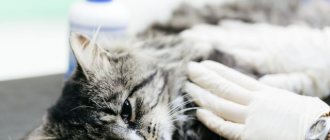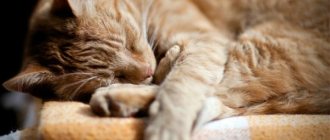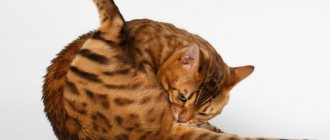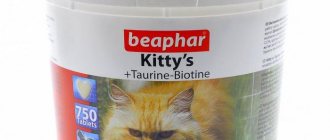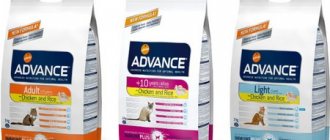Allergies have become a problem not only for humanity, but also for animals. Quite often this pathology occurs in cats. An allergic reaction is considered a very complex process that is provoked by various factors.
Allergy is a hypersensitivity of the immune system of the human or animal body, provoked by repeated exposure to allergens. In some cases, the body is able to remember an absolutely safe substance (allergen) and react to its influence again as if it were dangerous. When the rejection mechanism is activated, an allergic reaction begins.
Signs of an allergic reaction in cats
Allergies in cats, like in people, are provoked by various allergens; this reaction of the body has its own unique symptoms.
Allergy in a cat is manifested by the following symptoms:
- scratching on the dermis;
- skin redness;
- blisters;
- hair loss;
- papules;
- itching;
- vomit;
- nasal discharge;
- diarrhea;
- otitis;
- eczema.
The above signs of an allergic reaction can appear either individually or in combination. The severity of allergies does not depend on the amount of allergen that has entered the body. Even a small amount of an irritating factor can provoke an atypical reaction in a pet’s body.
Drugs for allergies in cats (a brief overview of systemic antihistamines)
Any antihistamine has its own exact dosage, exceeding which turns the medicine into a substance harmful to the cat with a lot of adverse reactions. This is the main reason why such medications should only be prescribed by a veterinarian.
Along with veterinary antihistamines, human drugs are effectively used for treatment according to long-developed and effectively implemented regimens.
Veterinary:
Used for allergic dermatitis. Prohibited for diabetes mellitus in cats, pregnant women, heart or kidney pathologies. Do not use for a long time due to the peculiarities of the glucogenic effect (increases blood sugar levels). Intramuscularly at 0.25-0.5 ml/head. every 24-48 hours |
Bravegil (up to 180 rub./amp or up to 120 rub./10 tablets)Widely used for all types of cat allergies. It is administered intramuscularly or given orally in tablet form. Slightly manifests itself in drowsiness. Not used during pregnancy. Dosage: 0.015-0.02 mg/kg once or twice a day (every 12-24 hours) (regardless of the route of administration). Can be used for a long time. |
It perfectly relieves allergic manifestations on a par with diphenhydramine, but has a longer lasting effect. Slightly causes drowsiness in cats. It is administered intramuscularly. Do not use for pregnant individuals. Apply 0.015-0.02 mg/kg twice a day after 12 hours. |
Human:
Effect: antihistamine, analgesic, sedative and hypnotic. The dosage is selected for each animal strictly individually, because It can have completely different effects on different cats, even in the same dosage. It is administered intramuscularly in an amount of 0.02-0.04 ml per 1 animal, in tablets orally the dosage is 1.5-2 more. Maximum twice a day for a week. |
Most often used for allergic reactions to insect bites. There is a hypnotic effect. The action is similar to diphenhydramine. Do not use in lactating animals or during pregnancy. It is forbidden to administer simultaneously with antipyretics. Orally at the rate of 1-4 mg of the drug, without mixing with food. You can repeat no earlier than after 8-12 hours. |
It has an antiallergic, psychotropic, sedative effect, suppresses the emetic effect. Relaxes smooth muscles, dilates bronchi and relieves pain (part of the piperazine range of drugs). Does not provoke addiction. Give orally at a dose of 5-10 mg/cat, repeated after 8-12 hours. |
Chlorpheniramine maleate (RUB 125-500)Works well on feline allergic dermatitis and urticaria. It is better to administer intramuscularly, because when it gets on the surface of the skin, it provokes a local irritant effect. When used orally, combine with or after feeding to reduce stomach irritation. Do not combine with alkaloids. Not suitable for long-term use - only for relief of acute increased individual reactions and no longer than 3 days. Dosage: 1-2 ml/animal intramuscularly or 2-4 ml/animal orally every day or 12 hours. |
Clemastine (Tavegil) (110-220 RUR/pack)Perfectly eliminates allergic symptoms in cats such as sneezing, runny nose and watery eyes. It has a long action time. It enhances the sedative effect of sedatives, so any drug combinations are not recommended. Side effects: diarrhea, thirst, lethargy or increased activity. The dosage does not depend on the weight of the animal: ½ tab. every 12 or 24 hours. |
Features of food allergies
Food allergies in cats are considered a fairly common type of atypical reaction in a pet. It accounts for about 10% of all cases of allergies in cats. It is at the third stage after a reaction to flea saliva, atopy (inhalation allergy).
Experts have not yet sufficiently studied the features of the processes in the gastrointestinal tract of cats that cause an atypical reaction of the body to certain food allergens. Although the disease process is still not fully understood, veterinarians have already identified the symptoms of food allergy in cats into a separate group, which we will consider below.
Allergic reactions in pets develop to the foods they most often consume. There is no definite connection between the breed, sex of the animal and the tendency to allergies, as is the case with atopy.
The first symptoms of an atypical reaction of the body to food can appear from five months. But most often the pathology is recorded in adult cats (2 – 6 years old). Along with food allergies, inhalation and contact allergies can develop.
It is very important to distinguish between diseases such as food allergies and food intolerances. In the first case, the pet has problems with the dermis and itching.
In the second case, there are no typical signs of allergies, but there is an upset stomach and diarrhea. You can avoid unpleasant conditions by eliminating foods that provoke illness from your cat’s diet.
Proper cat nutrition
To prevent allergies in your furry pet, you need to take care of its proper diet. Cats definitely need a lot of protein. It is important to diversify your diet by introducing different types of meat and fish into your diet. When eating a natural diet, proteins should be combined with rice, buckwheat, and oatmeal, but there should be little porridge, since excess carbohydrates are not good for the animals. But vegetables are necessary. You need to stew cabbage, broccoli, zucchini, cauliflower, carrots. Fermented milk products and egg yolk are also needed. Your pet's diet must be carefully prepared to ensure it does not lack essential nutrients.
If the owners decide to give their pet dry food, they also need to choose it carefully. This product should not contain soy, corn, or wheat. It is not advisable to feed your animal food that contains preservatives or dyes. You cannot give your pet food from the common table. You should also not add wet food. The cat should only eat the selected dry food.
Why do food allergies occur?
According to studies, some foods are more likely to provoke an atypical reaction in the body than others. The most common causes of food allergies in cats are:
- dairy products;
- mutton;
- soy;
- wheat gluten;
- corn;
- chicken;
- beef.
These foods are usually included in a cat's diet. Experts associate the frequency of an allergic reaction with the amount and duration of exposure to certain proteins.
The main signs of allergies in cats can be seen in the photo
| Flea allergic dermatitis | Allergy tests |
| Atopic dermatitis | Hives |
| Autoimmune pemphigus foliaceus | Allergic lacrimation |
| Autoimmune lupus erythematosus | Contact allergy to detergents |
| Food allergies | Allergy to meat protein |
Symptoms of food allergies
Food allergies in pets show the same symptoms as other types of allergic reactions. The main one is itching of the dermis. May also be present:
- miliary dermatitis;
- combing;
- hair loss.
Based on physical signs alone, it is fairly easy to differentiate a food allergy from atopy, another type of allergic reaction. In the first case, signs of pathology appear in winter, all year round. A peculiarity of the condition is the nuance that even steroid medications cannot remove the unbearable itching of the dermis.
When examining a cat, the veterinarian will pay attention first of all to the rash. It may initially be local. Then it spreads. The rash can cover large areas of the body. Over time, the rash can develop into allergic dermatitis. In this case, we should talk about the addition of a bacterial infection.
The second symptom that your veterinarian won't miss is itching. Cat allergies rarely occur without itching. Typically cats scratch the following parts of the body:
- ears;
- tail root;
- back.
The cause of itching is the production of biologically active substances (the body's response to the penetration of an allergen). Due to constant itching, the animal can damage the dermis, causing a secondary infection.
One of the signs of an allergy is redness of the dermis in the area of the ears and auricles. The cat begins to comb them. This can cause the appearance of otohematoma (accumulation of blood under the dermis of the auricle). Bald patches and severe hair loss may also occur. It is easiest to notice redness in hairless breeds of cats (bambino, sphinx). These breeds are considered to be highly allergic. After redness, the pet may experience dandruff and peeling of the dermis. Signs such as discharge from the nose and eyes may also indicate the presence of an allergic reaction.
You need to pay attention to the following characteristic signs of allergies in your pet:
- vomit;
- diarrhea;
- snore. The cause of this symptom is swelling of the nasal mucosa, difficulty passing air through the nose during sleep.
Treatment of allergic (atopic) dermatitis
Eliminating the cause or contact with the cause
Drug treatment will be ineffective if the allergen continues to affect the body. This point usually coincides with preventive measures for the occurrence of allergies, depending on the substances that cause the reaction:
Dust |
|
Mold |
|
Pollen |
|
Cutaneous blood-sucking parasites |
|
Household chemicals |
|
Application of local therapy
As a local antiallergic agent in cats, the use of only shampoos with hydrocortisone is justified. The effect is short-term, but immediate.
The use of ointments with hydrocortisone is justified only in the presence of itching and in small, hard-to-reach areas for licking. Ointments have virtually no adverse reactions due to the fact that they are practically not absorbed into the blood.
Prescription of biotin (vitamin B7) and preparations containing it
It has been proven that this vitamin in combination with omega fatty acids gives a noticeable effect in eliminating allergic dry skin, itching and seborrhea. With long-term use of the biotin + fatty acid complex by a cat in combination with antihistamines and diet, the need for steroids is significantly reduced.
Antihistamines
They are used as emergency aid and for long-term use to eliminate allergic symptoms or reduce their intensity. The dosage is always calculated individually.
Steroids
This group of drugs for systemic use is used in extreme cases, when all possible methods have been tried, but the effect is minimal or completely absent. Corticosteroids have many contraindications and side effects for cats, so it is important to follow the exact dosages and administration schedules that will be prescribed by your veterinarian. It is best to use injectable steroids (flumethasone, betamethasone, dexamethasone, methylprednisolone).
As for atopic dermatitis, unfortunately, it cannot be completely cured. All therapeutic measures are aimed at maximizing the relief of the animal’s condition and reducing the number of exacerbations. Those. this pathology is controllable. The treatment scheme is similar to the treatment of ordinary allergic dermatitis, only it is carried out almost constantly throughout the animal’s life.
Treatment of food allergies
- Eliminating the cause. After determining what type of product the cat is allergic to, it will have to be excluded forever.
- Consumption of a complex of fatty acids + biotin.
- Use of antihistamines.
- The use of steroids for food allergies is indicated when there is no relief in symptoms after all possible treatments. Until the cause is identified, it is usually not prescribed.
Treatment of infectious, parasitic and insect allergies
- Treatment of primary infectious disease. Before you begin direct treatment of allergies, you need to cure primary fungal, infectious or parasitic diseases. Treatment of the primary disease will be considered the elimination of the cause of the allergy.
- Destruction of blood-sucking parasites not only on the cat, but also in the premises where it lives.
- Deworming.
- Antihistamine therapy.
Allergic reaction to chicken
Very often, cats develop an allergy to chicken. This is explained by the fact that this ingredient is used in the manufacture of many pet foods. Once you have diagnosed an allergic reaction, it is very important to change your pet’s diet. If the cat eats natural food, you simply exclude chicken from the menu.
If you give your cat special food, choose the treat carefully. You can try giving him Orijen (with fish), Hills, Proplan (with lamb, fish). There are also special foods made specifically for allergy sufferers. They do not contain any components that provoke an allergic reaction in cats.
What to do at home
The owner must strictly follow the veterinarian's instructions. Self-medication can cause serious damage to the health of the animal.
Food allergies require dietary adjustments. It is necessary to switch the cat to medicinal hypoallergenic food. If dry food causes an allergic reaction, then you need to switch to natural feeding. Each new product is introduced gradually, while observing how the body perceives the innovation. If the allergy is caused by chicken, then not only poultry is removed from the diet, but also by-products and fats; if it is meat, then it is replaced with fish, etc.
If the replacement does not produce results, then the diet should be changed completely. The therapeutic diet includes lamb, veal, rabbit, and rice.
If the allergen cannot be identified, it is advisable to switch the cat to food with hydrolyzed protein, broken down to the level of amino acids. It is easily digestible and the body does not perceive it as a threat.
The tricky thing about allergies is that they are cumulative. Even a product from the diet that is used for a long period can cause a violent reaction, but it will give a reaction when the body is brought to a critical state.
In a house where a cat is kept, it is necessary to wash the floors, vacuum the carpets and upholstered furniture, and wipe the dust as often as possible. Detergents that may have caused allergies are replaced with safer ones.
To eliminate itching, the cat is washed with medicated shampoo. To enhance the therapeutic effect and protect against pathogenic microorganisms, antibiotics are added to the detergent.
Diagnosis of an allergic reaction to food
Diagnosing the body's specific reaction to food is quite simple. To prescribe the correct therapy for a cat, a specialist must conduct a differential diagnosis. It will help eliminate the likelihood of your pet developing other diseases. There is a certain list of diseases in which cats develop symptoms similar to food allergies:
- parasites of the digestive tract;
- atopy;
- fungal, bacterial infections;
- cat scabies;
- allergy to flea bites;
- seborrhea.
Having discovered specific signs of a cat’s allergies, his owner is faced with a new problem. He needs to establish the reason that provoked the development of such an atypical reaction. A qualified specialist from a veterinary hospital will help resolve this issue. The veterinarian will need to conduct a number of laboratory tests.
Causes of the disease
Allergy is a complex typical immunopathological process, expressed in the body’s immune response to exposure to a dangerous element (allergen) with the production of antibodies. A specific reaction occurs when fighting a foreign protein and is accompanied by the release of histamine.
The “aggressor” can be any substance, even a harmless one. So, the most common causes of allergies are:
- Food;
- chemicals;
- pollen, mold, dust;
- medications;
- litters used for cat litter boxes;
- waste products, saliva of parasites and blood-sucking insects;
- fur from other pets;
- the body's own cells.
Based on the factors that provoke allergies, several types of pathology are distinguished:
- atopic (foods, medications, mold);
- infectious (fungi, viruses, bacteria);
- parasitic-insect (parasites, worms);
- chemical (household chemicals, etc.).
Allergies according to the method of exposure are divided into autoimmune (reaction to one’s own cells), contact, and respiratory.
Allergy treatment
An allergic reaction in a cat is usually treated at home, but after examination by a veterinarian. It is this specialist who must determine the cause of the allergy and tell you how and with what to treat your pet.
Treatment of a cat must be carried out comprehensively. If the cause of a specific reaction in your pet’s body is flea bites, you need to immediately remove these parasites. The doctor can recommend effective, safe medications (Advantage, Stronghold, anti-flea shampoos). Wearing a special collar will help maintain the effect after eliminating fleas. For severe itching and swelling, the veterinarian may prescribe a course of antihistamines and corticosteroid medications.
If there is swelling of the paw pads, eczema, or peeling, the doctor can diagnose an allergy to cat litter. In this case, you must definitely change this remedy. It is recommended to choose a filler without small particles or odor. You can also change the brand and type of filler.
Antihistamines may be prescribed:
- Hydroxyzine;
- Diphenhydramine;
- Pipolzin;
- Tavegil;
- Chlorpheniramine;
- Diphenhydramine;
- Clemastine.
Treatments for food allergies
There is no specific test to determine food allergens in cats. Therefore, treatment of allergies caused by food begins with a diet based on the elimination method. Your cat should include only hypoallergenic foods on the menu:
- rabbit;
- lamb;
- barley;
- rice;
- salmon;
- veterinary dietary feeds.
This diet must be followed very strictly. A pet should not accept even the slightest treat from anyone. It is recommended to keep a special journal in which you should write down the menu for the day, the amount of food, and the animal’s reaction to food.
If the signs of food allergy completely disappear, they move on to the second step - a provoking diet. It consists of introducing one component and monitoring the pet’s reaction. In the absence of a specific reaction, another possible allergen is introduced. If the allergy recurs, you will be able to pinpoint the allergen and remove it from your pet’s diet forever.
The essence of allergies, causes and their classification
An allergy is a complex reactive process in a cat’s body when an ordinary and completely safe substance is perceived as something foreign and dangerous. This substance is called an allergen.
Immunity against allergens works in such a way that the “harmful” substance is not immediately eliminated from the body, but first an inflammatory process is provoked around it. Next, a substance such as histamine is released into the blood, which, acting on certain cellular receptors, becomes the culprit for the entire spectrum of clinical manifestations of the reactive state. A feature of all such reactions is the individual set of allergens and the unpredictability of symptoms.
Allergies can be caused by absolutely any substance:
- food (each cat has its own individual allergens);
- chemicals (shampoos, powders, cleaning agents and detergents, etc.);
- dust, mold, pollen;
- medicines;
- cat litter;
- saliva and waste products of blood-sucking insects and skin parasites;
- hair of other animals, dander or other gland secretions;
- the body's own cells.
How and how much to give?
Veterinarians do not recommend buying a turkey sealed in a vacuum bag, since pathogenic microorganisms multiply quickly in a humid environment and there is a high probability of buying a spoiled product.
Chicken can diversify your pet's meat diet.
The optimal amount of meat product is calculated based on the weight and age of the pet. However, the standard single portion is 30-35 g. You should not give your cat turkey every day, it is better not more than 2 times a week. Felinologists recommend alternating this type of meat with chicken and beef. To avoid the risk of parasite infection, you need to feed your cat boiled turkey meat. It is acceptable to give raw products if they have been stored in the freezer for 1 week before.
For kittens under 1 year of age, the meat should be boiled and pureed. It goes well with stewed vegetables, which will balance the animal’s diet. There is no need to fry or add oil to the turkey. It is important to remove all small bones, especially if the bird has been heat-treated. If a cat swallows a splinter, it can be fatal, especially in a kitten. With great caution, it is permissible to give large bones that the pet cannot swallow. Turkey allergies typically include rashes, scabies, and hair loss. If such symptoms appear, the bird should be removed from the menu.
